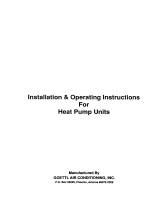
Table 6--Factory Defaults
FAILED COMPONENT
Ambient Thermistor
Outdoor Coil Thermistor
FUNCTION
Defrost Initiation
One minute fan off delay in cooling
greater than or equal to 100°F
Defrost Initiation and Termination
DEFAULT
Defrost is initiated based on coil
temperature and time.
No delay function
Defrost occurs at each time interval, but
terminate after 5 minutes
cooling or 5° above room ambient for heating.
6. Set room thermostat to COOL or HEAT and fan control to
AUTO or ON as desired. Wait for appropriate time delay(s).
Operate unit for 15 minutes. Check refrigerant charge.
NOTE: Ifunithas not operated within the past 12 hr or following
a unit power-up, upon the next thermostat high- or low-speed
demand, unit operates for a minimum of 5 minutes in high-speed.
Step 12--Check Charge
Service valve gage ports are not equipped with Schrader
valves. To prevent personal injury, make sure gage manifold
is connected to the valve gage ports before moving valves off
fully back seated position. Wear safety glasses and gloves
when handling refi'igerant.
UNIT CHARGE
Factory charge is shown on unit rating plate. With unit operating,
charge Puron¢_ units with liquid using a commercial type metering
device manifold hose. Charge refrigerant into suction line. To
check charge in cooling mode, refer to Cooling Only Procedure.
To check charge in heating mode, refer to Heating Check Chart
Procedure.
Adjust charge in both heating and cooling by following procedure
shown on charging tables located on unit pink charging label on
back side of access panel.
NOTE: Unit is to be charged ill high capacity only. Charging in
low capacity may cause compressor chattering and possible
damage to the compressor.
COOLING ONLY PROCEDURE
i. Operate unit a minimum of 15 minutes before checking
charge.
2. Measure liquid service valve pressure by attaching and insu-
lating an accurate Puron,_,R3gage to smwice port.
3. Measure liquid line temperature by attaching an accurate
thermistor type or electronic thermometer to liquid line near
outdoor coil.
4. Refer to charging label for required subcooling temperatures.
5. Refer to Table 3. Find the point where required subcooling
temperature intersects measured liqnid smwice valve pressure.
6. To obtain required subcooling temperature at a specific liquid
line pressure, add refrigerant if liquid line temperature is
higher than indicated or reclaim refrigerant if temperature is
lower. Allow a tolerance of ± 3°F.
HEATING CHECK CHARGE PROCEDURE
To check system operation during heating cycle, refer to the
Heating Pump Charging Instructions on outdoor unit. This chart
indicates whether a correct relationship exists between system
operating pressure and air temperature entering indoor and outdoor
units. If pressure and temperature do not match on chart, system
refrigerant charge may not be correct. Do not use chart to adjust
refrigerant charge.
NOTE: In heating mode, check refrigerant charge only when
pressures are stable. If accessory vapor pressure switch is applied
and operating conditions cause vapor pressure switch and thereby
outdoor fan to cycle, check refrigerant charge in cooling or lower
indoor dry bulb temperature. If in doubt, remove charge and weigh
in correct refrigerant charge.
NOTE: When charging is necessary during heating season,
charge must be weighed in accordance with unit rating plate ±0.6
ozift of 3/8-in. liquid line above or below 15 ft respectively.
EXAMPLE:
To calculate additional charge required for a 25-ft line set:
25 ft - 15 ft i0 ft X 0.6 ozift 6 oz of additional charge
Step 13--System Functions and Sequence of Operation
The outdoor unit control system has special functions. The
following is an overview of the two-speed control functions:
COOLING OPERATION
This product utilizes a 2-stage cooling indoor thermostat. With a
call for first stage cooling (Y1), the outdoor fan and low capacity
compressor are energized. If low capacity cannot satisfy cooling
demand, high capacity is energized (Y1 and Y2 or just Y2) by the
second stage of indoor thermostat. After second stage is satisfied,
the unit returns to low-capacity operation until first stage is
satisfied or until second stage is required again. When both first
stage and second stage cooling are satisfied, the compressor will
shut off.
NOTE: Ifunit has not operated within the past 12hr, or following
a unit power-up, upon the next thermostat high- or low-speed
demand, unit operates for a mininmm of 5 minutes on high speed.
NOTE: Outdoor fan motor will continue to operate for one
minute after compressor shuts off, when outdoor ambient is greater
than 10O°F.
NOTE: When two-speed unit is operating in low-capacity cool-
ing, system vapor (suction) pressure will be higher than a standard
single-speed system or high-speed operation. This normal opera-
tion is due to the reduced capacity operating with typically larger
indoor and outdoor coils.
HEATING OPERATION
This product utilizes a 3-stage heating indoor thermostat. With a
call for first stage heating (Y1), the outdoor fan and low capacity
compressor are energized. If low capacity cannot satisfy heating
demand, high capacity is energized (Y1 and Y2) by the second
stage of the indoor thermostat. Auxiliary or back up heat is
controlled by third stage (Wl). After second stage of heat is
satisfied, the unit returus to low capacity operation until first stage
is satisfied or until second stage is required again. When both first
stage and second stage heating are satisfied, the compressor will
shut off.
NOTE: Ifunit has not operated within the past 12hr, or following
a unit power-up, upon the next thermostat high- or low-speed
demand, unit operates for a mininmm of 5 minutes on high speed.

















